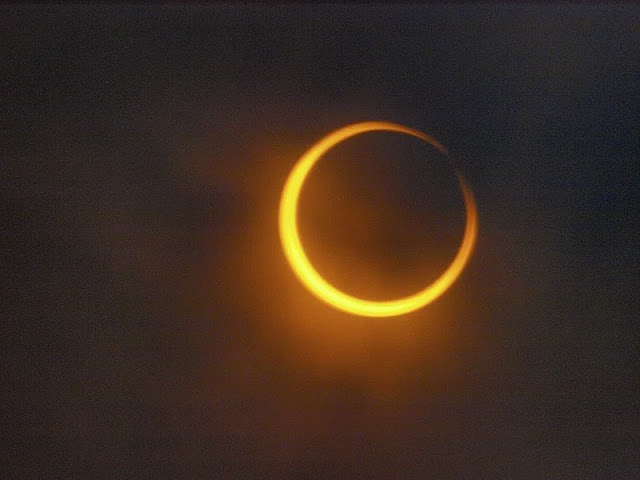Solar eclipses have captivated humanity for centuries, inspiring awe and wonder as the moon momentarily blocks the sun's light. These celestial events, occurring when the moon passes between the Earth and the sun, have sparked both scientific curiosity and cultural significance throughout history. In this article, we explore the recent prominent solar eclipse, delve into the science behind eclipses, and examine the diverse beliefs and myths associated with these awe-inspiring phenomena.
A stunning astronomical phenomenon took place over North America on April 8th, 2024. A full solar eclipse occurred, with the moon entirely obscuring the sun's light, creating a shadow over sections of Mexico, the United States, and Canada, impressing millions.
This unusual occurrence attracted many excited onlookers, equipped with eclipse glasses for a safe view of the event. Hotels and travel operators in cities along the path of totality saw an increase in visitors, with all accommodations fully booked. Excitement spread on social media as users posted pictures and videos of the eclipse, capturing the spectacular event.
The Last Prominent Solar Eclipse:The most recent significant solar eclipse occurred on December 4, 2021. This was a partial solar eclipse, visible in various parts of the world, including Antarctica, southern Africa, and parts of Australia. While not a total eclipse, where the sun is completely obscured by the moon, it still offered a breathtaking spectacle as the moon partially blocked the sun, casting a shadow over the Earth and dimming the sky.
Science Behind Solar Eclipses:Solar eclipses occur when the moon, in its orbit around the Earth, passes between the Earth and the sun, aligning in such a way that it blocks the sun's light from reaching certain parts of the Earth's surface. There are three types of solar eclipses: total, partial, and annular. A total eclipse occurs when the moon completely covers the sun, casting a shadow known as the umbra. A partial eclipse happens when only a portion of the sun is obscured by the moon, and an annular eclipse occurs when the moon appears smaller than the sun, leaving a ring of sunlight visible around its edges.
Cultural and Mythological Beliefs:Solar eclipses have long been imbued with cultural significance and mythological interpretations across various civilizations. Here are some beliefs and traditions associated with solar eclipses:
Mythological Interpretations: In ancient cultures such as those of the Greeks, Egyptians, and Chinese, solar eclipses were often interpreted as omens or portents of significant events. They were sometimes viewed as signs of divine displeasure or impending disaster.
Mythological Creatures: In some cultures, myths and legends arose to explain solar eclipses. For example, in Norse mythology, it was believed that the sun was swallowed by a mythical wolf named Skoll during an eclipse, only to be released once the eclipse passed.
Cultural Practices: Many cultures developed rituals and customs associated with solar eclipses. In ancient China, for instance, people would bang drums and pots to scare away the dragon they believed was swallowing the sun. Similarly, in Hindu tradition, it is common to take a ritual bath after an eclipse to cleanse oneself of any negative energy.
Modern Interpretations: While modern science has provided a rational understanding of solar eclipses, they continue to hold cultural significance for many people around the world. Eclipse-chasing has become a popular activity, with enthusiasts traveling to witness these awe-inspiring events firsthand.
Solar eclipses are extraordinary celestial events that have fascinated and inspired humanity for millennia. While modern science has demystified the mechanics behind eclipses, they continue to evoke wonder and awe across cultures worldwide. Whether viewed through the lens of science or steeped in myth and tradition, solar eclipses serve as a powerful reminder of the interconnectedness of Earth and the cosmos, sparking curiosity and contemplation among all who witness them.
Mythical Stories about SOLAR eclipse
Tales from History:
Here are a few mythical stories about solar eclipses from history, showcasing the diverse explanations cultures developed for this phenomenon:
Rahu Devouring the Sun (India): In Hindu mythology, a demon named Rahu attempts to drink the nectar of immortality during a celestial banquet. He is promptly beheaded by Vishnu, the god responsible for maintaining cosmic order. However, Rahu's immortal head remains in the sky, chasing the sun and moon. When it catches up, it swallows the sun, causing a solar eclipse.
Sky Wolves Devouring the Sun (Norse Mythology): Norse mythology paints a fierce picture. Two monstrous wolves, Skoll and Hati, are destined to chase the sun and moon across the sky. During a solar eclipse, Skoll is believed to have temporarily caught up to the sun, engulfing it in its darkness.
Celestial Dog Stealing the Sun (Vietnam): Vietnamese cultures tell a tale of a giant celestial dog. This ravenous canine is said to occasionally chase and snatch the sun, causing a solar eclipse.
The Battling Sun and Moon (Inuit Mythology): The Inuit people of North America have a story about a celestial fight. Here, the sun (Malina) and the moon (Anningan) are depicted as a brother and sister who get into a quarrel. When Anningan manages to catch up with Malina, it results in a solar eclipse.
Disappearing Sun Due to Anger (Transylvanian Folklore): A more human-centric explanation comes from Transylvania. This folklore suggests the sun is a sentient being who gets angry at the misdeeds of humanity. During a solar eclipse, the sun is said to turn away and hide its light in response to human behavior.
Shocking Beliefs about LUNAR Eclipse ~> Read more Click HERE


No comments:
Post a Comment